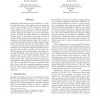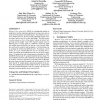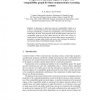117
click to vote
ICCV
2011
IEEE
14 years 13 days ago
2011
IEEE
We propose a mid-level statistical model for image segmentation that composes multiple figure-ground hypotheses (FG) obtained by applying constraints at different locations and s...
117
Voted
DM
2002
15 years 7 days ago
2002
The edge clique graph of a graph G is one having as vertices the edges of G, two vertices being adjacent if the corresponding edges of G belong to a common clique. We describe cha...
101
click to vote
TCS
2008
15 years 10 days ago
2008
Reporting the maximal cliques of a graph is a fundamental problem arising in many areas. This note bridges the gap between three papers addressing this problem: the original paper...
120
click to vote
ALMOB
2006
15 years 15 days ago
2006
Given a set S of n locally aligned sequences, it is a needed prerequisite to partition it into groups of very similar sequences to facilitate subsequent computations, such as the ...
111
click to vote
COMAD
2009
15 years 1 months ago
2009
Identifying communities in social networks is a problem of great interest. One popular type of community is where every member of the community knows all others, which can be view...
106
Voted
NIPS
2001
15 years 1 months ago
2001
Motivated by our recent work on rooted tree matching, in this paper we provide a solution to the problem of matching two free (i.e., unrooted) trees by constructing an association...
108
Voted
NIPS
2001
15 years 1 months ago
2001
We present an algorithm that induces a class of models with thin junction trees--models that are characterized by an upper bound on the size of the maximal cliques of their triang...
102
Voted
SIGMOD
2010
ACM
15 years 5 months ago
2010
ACM
Maximal clique enumeration (MCE) is a fundamental problem in graph theory and has important applications in many areas such as social network analysis and bioinformatics. The prob...
103
Voted
ASP
2003
Springer
15 years 5 months ago
2003
Springer
In this paper we define the notion of a compatibility relation so as to have a common framework for three nonmonotonic reasoning systems: normal logic programming, extended logic ...
119
click to vote
ESA
2005
Springer
15 years 6 months ago
2005
Springer
Abstract. We provide new tools, such as k-troikas and good subtreerepresentations, that allow us to give fast and simple algorithms computing branchwidth. We show that a graph G ha...




